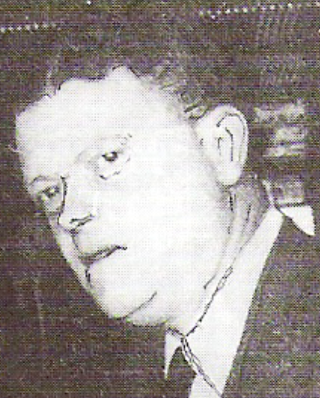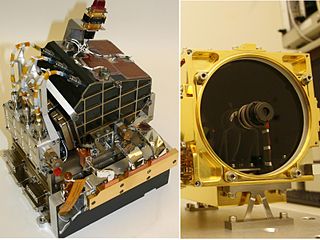
Atomic absorption spectroscopy (AAS) and atomic emission spectroscopy (AES) is a spectroanalytical procedure for the quantitative determination of chemical elements by free atoms in the gaseous state. Atomic absorption spectroscopy is based on absorption of light by free metallic ions.
Gold fingerprinting is a method of identifying an item made of gold based on the impurities or trace elements it contains.

Sir Harold Warris Thompson, CBE, FRS was an English physical chemist and spectroscopist, who also served as chairman of the Football Association.

Laser-induced breakdown spectroscopy (LIBS) is a type of atomic emission spectroscopy which uses a highly energetic laser pulse as the excitation source. The laser is focused to form a plasma, which atomizes and excites samples. The formation of the plasma only begins when the focused laser achieves a certain threshold for optical breakdown, which generally depends on the environment and the target material.
Photoacoustic spectroscopy is the measurement of the effect of absorbed electromagnetic energy on matter by means of acoustic detection. The discovery of the photoacoustic effect dates to 1880 when Alexander Graham Bell showed that thin discs emitted sound when exposed to a beam of sunlight that was rapidly interrupted with a rotating slotted disk. The absorbed energy from the light causes local heating, generating a thermal expansion which creates a pressure wave or sound. Later Bell showed that materials exposed to the non-visible portions of the solar spectrum can also produce sounds.

Inductively coupled plasma atomic emission spectroscopy (ICP-AES), also referred to as inductively coupled plasma optical emission spectroscopy (ICP-OES), is an analytical technique used for the detection of chemical elements. It is a type of emission spectroscopy that uses the inductively coupled plasma to produce excited atoms and ions that emit electromagnetic radiation at wavelengths characteristic of a particular element. The plasma is a high temperature source of ionised source gas. The plasma is sustained and maintained by inductive coupling from electrical coils at megahertz frequencies. The source temperature is in the range from 6000 to 10,000 K. The intensity of the emissions from various wavelengths of light are proportional to the concentrations of the elements within the sample.
Acta Crystallographica is a series of peer-reviewed scientific journals, with articles centred on crystallography, published by the International Union of Crystallography (IUCr). Originally established in 1948 as a single journal called Acta Crystallographica, there are now six independent Acta Crystallographica titles:
Velmer A. Fassel was an American chemist who developed the inductively coupled plasma (ICP) and demonstrated its use as ion source for mass spectrometry.

Sir Alan Walsh FAA FRS was a British-Australian physicist, originator and developer of a method of chemical analysis called atomic absorption spectroscopy.
Acta Physica Polonica is an open access peer-reviewed scientific journal covering research in physics. It was established by the Polish Physical Society in 1920 as Comptes Rendus des Séances de la Société Polonaise de Physique. In 1970 is split into two journals Acta Physica Polonica A and Acta Physica Polonica B. The two journals became independent in 1995, with series A published by the Institute of Physics of the Polish Academy of Sciences and series B published by the Jagiellonian University in cooperation with the Polish Academy of Arts and Sciences.

3-Hydroxyflavone is a chemical compound. It is the backbone of all flavonols, a type of flavonoid. It is a synthetic compound, which is not found naturally in plants. It serves as a model molecule as it possesses an excited-state intramolecular proton transfer (ESIPT) effect to serve as a fluorescent probe to study membranes for example or intermembrane proteins. The green tautomer emission and blue-violet normal emission originate from two different ground state populations of 3HF molecules. The phenomenon also exists in natural flavonols. Although 3-hydroxyflavone is almost insoluble in water, its aqueous solubility can be increased by encapsulation in cyclodextrin cavities.
Azam Ali is a Bangladeshi scientist known internationally as biomaterials and bioengineering experts for having developed a wound dressing, which earned him the Bayer Innovators Award in 2010.

Spectrochimica Acta Part A: Molecular and Biomolecular Spectroscopy is a monthly peer-reviewed scientific journal covering spectroscopy.

Chemistry and Camera complex (ChemCam) is a suite of remote sensing instruments on Mars for the Curiosity rover. As the name implies, ChemCam is actually two different instruments combined as one: a laser-induced breakdown spectroscopy (LIBS) and a Remote Micro Imager (RMI) telescope. The purpose of the LIBS instrument is to provide elemental compositions of rock and soil, while the RMI will give ChemCam scientists high-resolution images of the sampling areas of the rocks and soil that LIBS targets. The LIBS instrument can target a rock or soil sample from up to 7 m (23 ft) away, vaporizing a small amount of it with about 30 5-nanosecond pulses from a 1067 nm infrared laser and then observing the spectrum of the light emitted by the vaporized rock.

Glow-discharge optical emission spectroscopy (GDOES) is a spectroscopic method for the quantitative analysis of metals and other non-metallic solids. The idea was published and patented in 1968 by Werner Grimm from Hanau, Germany.

Gary M. Hieftje is an analytical chemist, Distinguished Professor, and the Robert & Marjorie Mann Chair of Chemistry at Indiana University in Bloomington, Indiana. Gary M. Hieftje received his A.B. degree at Hope College in Holland, Michigan in 1964, and his PhD from University of Illinois at Urbana–Champaign in 1969. In 1969, he started his career in teaching and research at Indiana University. Hieftje was named a Distinguished Professor in 1985, and entered emeritus status in 2018. As of 2018, Dr. Hieftje has been involved in over 600 publications.

Robin Jon Hawes Clark was a New Zealand-born chemist initially noted for research of transition metal and mixed-valence complexes, and later for the use of Raman spectroscopy in determining the chemical composition of pigments used in artworks.
Stewart F. Parker is a British scientist specialising in vibrational spectroscopy and catalysis. He works at the ISIS neutron source and is an Honorary Professor in the school of Chemistry at the University of Glasgow.
Candice Mae Bridge is an American chemist and Associate Professor of Chemistry and Forensic Science at the University of Central Florida. Her research considers the development of mass spectroscopy for forensic analysis, including the characterization of lubricant from rape victims and residue from gunshots, as well as the identification of drugs in urine samples.











